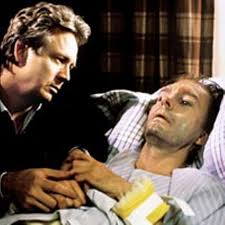By FRANK RIZZO
Long before the utopian rom-com Fire Island, there was a movie that told a far darker and disturbing story, set principally on that LGBTQ+ sunny enclave at a perilous time: the 1989 landmark film, Longtime Companion.
Though there were several plays and a TV movie (An Early Frost) that dealt with the AIDS epidemic, Longtime Companion was the first major commercial film dealing directly with the subject seen through a gay perspective. The film was released at the time the deadly HIV virus was still raging—and the numbers were still climbing, taking tens of thousands of lives from the LBGTQ+ community—with no end or treatments in sight.
The film project began when Lindsay Law, executive producer for PBS’s American Playhouse series, asked playwright Craig Lucas (Reckless, Prelude to a Kiss) to write a screenplay.
The story Lucas chose centers on a group of upper- and middle-class gay men and the effect of the AIDS on this group from 1981, when the virus first appeared in the mainstream, to 1989. The film opens with a group of gay men summering on Fire Island and discussing a New York Times story identifying a “rare cancer” in “41 homosexuals.” (The film’s title was a euphemism in newspaper obituaries for lovers of gay men and women.)
The project was seemingly an unsurmountable challenge to finance, produce,and distribute. In the end Law and American Playhouse bankrolled the entire project, with the original budget of $3 million halved to $1.5 million.
“It’s the combination of AIDS and the gay community,” Law told me at the time of the movie’s release. “We would have had a better chance of getting it made if it dealt with AIDS from the point of view of drug addicts, I also think we will shock some people that we portray the [gay] lifestyle in such a matter-of- fact way.”
The film would have been far easier to finance if any of the big-name actors who were approached signed on—except for Alec Baldwin, whose star was quickly rising. But he had to drop out when he was offered Hollywood’s most sought-after roles at the time: the lead in The Hunt for Red October. In the end, the cast was made up of talented but hardly well-known actors then: Bruce Davison, Campbell Scott, Patrick Cassidy, Mary-Louise Parker, John Dossett, Dermot Mulroney, Stephen Caffrey—and Mark Lamos in his first screen role, who was artistic director of Hartford Stage at the time and the only gay cast member—”as far as I know,” he says.
The film was directed by Norman Rene, who had staged many of Lucas’ plays.(René died of complications from AIDS in 1996.) Stan Wlodkowski, a West Hartford native, was a producer of the film, which was eventually distributed by The Samuel Goldwyn Company.
“I was moved to tears when I read the screenplay and knew that I had to be involved with this,” Wlodkowski told me at the time.”I think one of the things that makes the film successful is that it emphasizes how a community comes together to take care of itself.”
Those involved with the film knew they were involved in a project that was not just another movie, says Lamos.
“We were all aware of the film’s importance and worried it wouldn’t get a distributor, so when word came through that Samuel Goldwyn had signed on, everyone was cheering and crying.”
There were challenges in filming, too. During the shooting on Fire Island, “there were residents there who demonstrated and tried to disrupt the scenes with noisemakers and stuff,” says Lamos. “They acted like they didn’t want people to know that there were gay people on Fire Island and had gay people who lived there who were getting sick. It wasn’t a huge group [of protestors] but enough to make us very worried because if Fire Island was going to be against us, then we were going to be in real trouble.”
Lamos played a 40-ish gay man in a committed relationship with his partner, played by Davison, who earned an Oscar nomination for the role—the Academy’s first recognition of AIDS, which predated Philadelphia with Tom Hanks and Denzel Washington by four years. Lamos’ character dies from the disease in a scene that was one of many memorable and heart-breaking moments in the film.
“Norman was very emotional during the shooting of that scene and he was trying to keep [his emotions] at bay. As for me, I was like having an out-of-body experience. I looked so terrible with the make-up and wig, and I had to lose so much weight for that scene. It was the last scene we shot, and I really had to look as thin as possible.”
The film was a critical success and has become a beloved classic in LGBTQ+ cinema.
Lamos says he has been stopped on the street more than a few times by strangers who thanked him “for helping them deal with the death of someone they knew. Those instances were very emotional, and it was tremendously gratifying to know you’ve helped someone because of your performance.”
Though it did deal with tragic circumstances, the film’s humor and life-loving characters kept it from being unbearably painful. The emotional wallop of the film’s ending was both uplifting and heartbreaking as it depicted a fantasy moment where scores of gay men who had died from the disease were all lovingly reunited on the island’s beach. (The end of the first half of the Tony Award-winning play The Inheritance has striking echoes of the film’s wish-fulfilling ending.)
Lamos says he saw the film again a few years ago during a gay history salute on television “and I loved it and I thought, ‘What a good movie this is.’”
But it was also bittersweet, he says, reminding him of those who died and those who survived. “I watched it in the context that we got through the crisis, for the most part. Now we have friends who are living and healthy on medication and who are here as we age together. It was a relief of sorts but it was still shocking to see again what we were all going through back then.”









More Stories
Broadway Review: Art
Fall Arts Preview: Emus, Foxes and Eric Clapton, Too
Diane DiMassa Book Event September 25